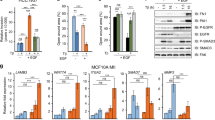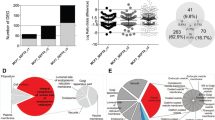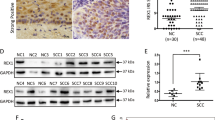Abstract
Deregulation of the transforming growth factor β (TGFβ) signal transduction cascade is functionally linked to cancer. In early phases, TGFβ acts as a tumor suppressor by inhibiting tumor cell proliferation, whereas in late phases, it can act as a tumor promoter by stimulating tumor cell invasion and metastasis. Smad transcriptional effectors mediate TGFβ responses, but relatively little is known about the Smad-containing complexes that are important for epithelial–mesenchymal transition and invasion. In this study, we have tested the hypothesis that specific members of the AP-1 transcription factor family determine TGFβ signaling specificity in breast cancer cell invasion. Using a 3D model of collagen-embedded spheroids of MCF10A-MII premalignant human breast cancer cells, we identified the AP-1 transcription factor components c-Jun, JunB, c-Fos and Fra1 as essential factors for TGFβ-induced invasion and found that various mesenchymal and invasion-associated TGFβ-induced genes are co-regulated by these proteins. In situ proximity ligation assays showed that TGFβ signaling not only induces complexes between Smad3 and Smad4 in the nucleus but also complexes between Smad2/3 and Fra1, whereas complexes between Smad3, c-Jun and JunB could already be detected before TGFβ stimulation. Finally, chromatin immunoprecipitations showed that c-Jun, JunB and Fra1, but not c-Fos, are required for TGFβ-induced binding of Smad2/3 to the mmp-10 and pai-1 promoters. Together these results suggest that in particular formation of Smad2/3-Fra1 complexes may reflect activation of the Smad/AP-1-dependent TGFβ-induced invasion program.
This is a preview of subscription content, access via your institution
Access options
Subscribe to this journal
Receive 50 print issues and online access
$259.00 per year
only $5.18 per issue
Buy this article
- Purchase on Springer Link
- Instant access to full article PDF
Prices may be subject to local taxes which are calculated during checkout






Similar content being viewed by others
References
Heldin CH, Moustakas A . Role of Smads in TGFβ signaling. Cell Tissue Res 2012; 347: 21–36.
Schmierer B, Hill CS . TGFβ-SMAD signal transduction: molecular specificity and functional flexibility. Nat Rev Mol Cell Biol 2007; 8: 970–982.
Zhang Y, Feng XH, Derynck R . Smad3 and Smad4 cooperate with c-Jun/c-Fos to mediate TGF-β -induced transcription. Nature 1998; 394: 909–913.
Javelaud D, Mauviel A . Crosstalk mechanisms between the mitogen-activated protein kinase pathways and Smad signaling downstream of TGF-β: implications for carcinogenesis. Oncogene 2005; 24: 5742–5750.
Ross S, Hill CS . How the Smads regulate transcription. Int J Biochem Cell Biol 2008; 40: 383–408.
Massagué J . TGFβ in cancer. Cell 2008; 134: 215–230.
Koinuma D, Tsutsumi S, Kamimura N, Taniguchi H, Miyazawa K, Sunamura M et al. Chromatin immunoprecipitation on microarray analysis of Smad2/3 binding sites reveals roles of ETS1 and TFAP2A in transforming growth factor β signaling. Mol Cell Biol 2009; 29: 172–186.
ten Dijke P, Arthur HM . Extracellular control of TGFβ signalling in vascular development and disease. Nat Rev Mol Cell Biol 2007; 8: 857–869.
Xu J, Lamouille S, Derynck R . TGF-β-induced epithelial to mesenchymal transition. Cell Res 2009; 19: 156–172.
Comijn J, Berx G, Vermassen P, Verschueren K, van Grunsven L, Bruyneel E et al. The two-handed E box binding zinc finger protein SIP1 downregulates E-cadherin and induces invasion. Mol Cell 2001; 7: 1267–1278.
Thuault S, Tan EJ, Peinado H, Cano A, Heldin CH, Moustakas A . HMGA2 and Smads co-regulate SNAIL1 expression during induction of epithelial-to-mesenchymal transition. J Biol Chem 2008; 283: 33437–33446.
Zavadil J, Bitzer M, Liang D, Yang YC, Massimi A, Kneitz S et al. Genetic programs of epithelial cell plasticity directed by transforming growth factor-β. Proc Natl Acad Sci USA 2001; 98: 6686–6691.
Derynck R, Zhang YE . Smad-dependent and Smad-independent pathways in TGF-β family signalling. Nature 2003; 425: 577–584.
Mu Y, Gudey SK, Landström M . Non-Smad signaling pathways. Cell Tissue Res 2012; 347: 11–20.
Deckers M, van Dinther M, Buijs J, Que I, Löwik C, van der Pluijm G et al. The tumor suppressor Smad4 is required for transforming growth factor β-induced epithelial to mesenchymal transition and bone metastasis of breast cancer cells. Cancer Res 2006; 66: 2202–2209.
Dzwonek J, Preobrazhenska O, Cazzola S, Conidi A, Schellens A, van Dinther M et al. Smad3 is a key nonredundant mediator of transforming growth factor β signaling in Nme mouse mammary epithelial cells. Mol Cancer Res 2009; 7: 1342–1353.
Shaulian E, Karin M . AP-1 in cell proliferation and survival. Oncogene 2001; 20: 2390–2400.
van Dam H, Castellazzi M . Distinct roles of Jun: Fos and Jun: ATF dimers in oncogenesis. Oncogene 2001; 20: 2453–2464.
Hess J, Angel P, Schorpp-Kistner M . AP-1 subunits: quarrel and harmony among siblings. J Cell Sci 2004; 117: 5965–5973.
Lopez-Bergami P, Lau E, Ronai Z . Emerging roles of ATF2 and the dynamic AP1 network in cancer. Nat Rev Cancer 2010; 10: 65–76.
Eferl R, Wagner EF . AP-1: a double-edged sword in tumorigenesis. Nat Rev Cancer 2003; 3: 859–868.
Belguise K, Kersual N, Galtier F, Chalbos D . FRA-1 expression level regulates proliferation and invasiveness of breast cancer cells. Oncogene 2005; 24: 1434–1444.
Ozanne BW, Spence HJ, McGarry LC, Hennigan RF . Transcription factors control invasion: AP-1 the first among equals. Oncogene 2007; 26: 1–10.
Wiercinska E, Naber HP, Pardali E, van der Pluijm G, van Dam H, Ten Dijke P . The TGF-β/Smad pathway induces breast cancer cell invasion through the up-regulation of matrix metalloproteinase 2 and 9 in a spheroid invasion model system. Breast Cancer Res Treat 2011; 128: 657–666.
Laverty HG, Wakefield LM, Occleston NL, O'Kane S, Ferguson MW . TGF-β3 and cancer: a review. Cytokine Growth Factor Rev 2009; 20: 305–317.
Tang B, Vu M, Booker T, Santner SJ, Miller FR, Anver MR et al. TGF-β switches from tumor suppressor to prometastatic factor in a model of breast cancer progression. J Clin Invest 2003; 112: 1116–1124.
Verde P, Casalino L, Talotta F, Yaniv M, Weitzman JB . Deciphering AP-1 function in tumorigenesis: fra-ternizing on target promoters. Cell Cycle 2007; 6: 2633–2639.
Söderberg O, Gullberg M, Jarvius M, Ridderstråle K, Leuchowius KJ, Jarvius J et al. Direct observation of individual endogenous protein complexes in situ by proximity ligation. Nat Methods 2006; 3: 995–1000.
Baan B, Pardali E, ten Dijke P, van Dam H . In situ proximity ligation detection of cJun/AP-1 dimers reveals increased levels of cJun/Fra1 complexes in aggressive breast cancer cell lines in vitro and in vivo. Mol Cell Proteomics 2010; 9: 1982–1990.
Dumont N, Arteaga CL . Transforming growth factor-β and breast cancer: tumor promoting effects of transforming growth factor-β. Breast Cancer Res 2000; 2: 125–132.
Wakefield LM, Piek E, Bottinger EP . TGF-β signaling in mammary gland development and tumorigenesis. J Mammary Gland Biol Neoplasia 2001; 6: 67–82.
Gomis RR, Alarcon C, Nadal C, Van PC, Massagué J . C/EBPβ at the core of the TGFβ cytostatic response and its evasion in metastatic breast cancer cells. Cancer Cell 2006; 10: 203–214.
Levy L, Hill CS . Alterations in components of the TGF-β superfamily signaling pathways in human cancer. Cytokine Growth Factor Rev 2006; 17: 41–58.
Sjöblom T, Jones S, Wood LD, Parsons DW, Lin J, Barber TD et al. The consensus coding sequences of human breast and colorectal cancers. Science 2006; 314: 268–274.
Leary RJ, Lin JC, Cummins J, Boca S, Wood LD, Parsons DW et al. Integrated analysis of homozygous deletions, focal amplifications, and sequence alterations in breast and colorectal cancers. Proc Natl Acad Sci USA 2008; 105: 16224–16229.
Sundqvist A, ten Dijke P, van Dam H . Key signaling nodes in mammary gland development and cancer: Smad signal integration in epithelial cell plasticity. Breast Cancer Res 2012; 14: 204–216.
Parvani JG, Taylor MA, Schiemann WP . Noncanonical TGF-β signaling during mammary tumorigenesis. J Mammary Gland Biol Neoplasia 2011; 16: 127–146.
Wagner EF . Bone development and inflammatory disease is regulated by AP-1 (Fos/Jun). Ann Rheum Dis 2010; 69 (Suppl 1): i86–i88.
Reichmann E, Schwarz H, Deiner EM, Leitner I, Eilers M, Berger J et al. Activation of an inducible c-FosER fusion protein causes loss of epithelial polarity and triggers epithelial-fibroblastoid cell conversion. Cell 1992; 71: 1103–1116.
Luo YP, Zhou H, Krueger J, Kaplan C, Liao D, Markowitz D et al. The role of proto-oncogene Fra-1 in remodeling the tumor microenvironment in support of breast tumor cell invasion and progression. Oncogene 2010; 29: 662–673.
Verrecchia F, Tacheau C, Schorpp-Kistner M, Angel P, Mauviel A . Induction of the AP-1 members c-Jun and JunB by TGF-β/Smad suppresses early Smad-driven gene activation. Oncogene 2001; 20: 2205–2211.
Acknowledgements
We thank our colleagues, in particular Aris Moustakas and Masato Morikawa, for their valuable discussion and help with experiments. This work was supported by the Swedish Cancerfonden (090773) and the Netherlands Centre for Biomedical Genetics.
Author information
Authors and Affiliations
Corresponding author
Ethics declarations
Competing interests
UL is a founder of Olink Bioscience, which commercializes the in situ PLA technology.
Additional information
Supplementary Information accompanies the paper on the Oncogene website
Supplementary information
Rights and permissions
About this article
Cite this article
Sundqvist, A., Zieba, A., Vasilaki, E. et al. Specific interactions between Smad proteins and AP-1 components determine TGFβ-induced breast cancer cell invasion. Oncogene 32, 3606–3615 (2013). https://doi.org/10.1038/onc.2012.370
Received:
Revised:
Accepted:
Published:
Issue Date:
DOI: https://doi.org/10.1038/onc.2012.370
Keywords
This article is cited by
-
Injury-induced cooperation of InhibinβA and JunB is essential for cell proliferation in Xenopus tadpole tail regeneration
Scientific Reports (2024)
-
In silico and in vitro studies of novel cyanoacrylamides incorporating pyrazole moiety against breast and prostate carcinomas
Medicinal Chemistry Research (2023)
-
CHD1 loss negatively influences metastasis-free survival in R0-resected prostate cancer patients and promotes spontaneous metastasis in vivo
Cancer Gene Therapy (2022)
-
JUNB suppresses distant metastasis by influencing the initial metastatic stage
Clinical & Experimental Metastasis (2021)
-
The nuclear oncoprotein Fra-1: a transcription factor knocking on therapeutic applications’ door
Oncogene (2020)



